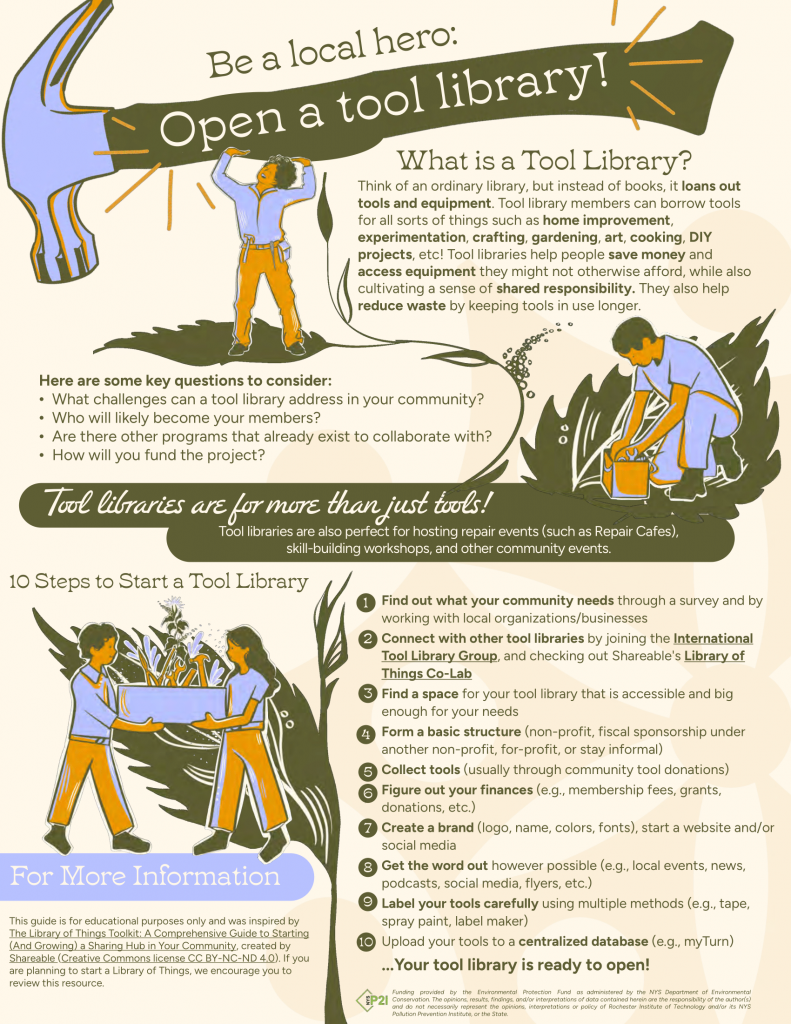Libraries can offer a lot more than just books. Whether it’s a sewing kit or a step ladder, tool libraries can provide sustainable solutions for communities to complete their personal projects in a way that promotes reuse, discourages needless consumerism, and saves people money.
The Institute for Sustainability Engagement (ISE) has prepared a printable 10-step guide to help anyone get started implementing a tool library in their community. This guide stems from ISE’s role in helping develop a tool lending library in Keeseville, NY (more on this in “About the Guide” section).

Click HERE to download, and read below for more.
The majority of the textual contents of this PDF guide are in this article, slightly edited.
The following guidance comes from a public resource created by ISE.
What is a Tool Library?
Think of an ordinary library, but instead of books, it loans out tools and equipment. Tool library members can borrow tools for all sorts of things such as home improvement, experimentation, crafting, gardening, art, cooking, DIY projects, etc.
Why Tool Libraries Matter
Tool libraries help people save money and access equipment they might not otherwise afford, while also cultivating a sense of shared responsibility. They also help reduce waste and emissions by keeping tools in use longer. Beyond these practical benefits, tool libraries can bring communities together through skill sharing, learning, and community support- especially in times of need.
Tool libraries are for more than just tools!
Tool libraries are also perfect for hosting free community repair events (such as Repair Cafes), skill-building workshops, and other community events.
How to Start a Tool Library
Start by answering some foundational questions:
- What is your primary motivation?
- What does your community need?
- What challenges can a tool library address in your community?
- Who will help you coordinate this?
- Who will likely become your members?
- Are there other programs that already exist that you can build from?
- How will you fund the project?
- How much (if anything) will you charge for membership, and how long are memberships (annual, monthly, etc.)?
Then, follow these 10 steps:
10 Steps to Start a Tool Library
- Find out what your community needs (community survey, connect with local community organizations & small businesses)
- Connect with other tool libraries and Library of Things and join the International Tool Library Group to ask questions, attend webinars, etc.
- Find a space for your tool library that is accessible and big enough for your needs
- Form a basic structure (non-profit, fiscal sponsorship under another non-profit, for-profit, or stay informal)
- Collect tools (usually through community tool donations)
- Figure out your finances (e.g., membership fees, grants, donations, etc.)
- Create a brand (logo, name, colors, fonts) & start a website and/or social media
- Get the word out however possible (e.g., local events, news, podcasts, social media, flyers, etc.)
- Label your tools carefully using multiple methods (e.g., tape, spray paint, label maker)
- Upload your tools to a centralized database (e.g., myTurn), ideally viewed publicly online
- Your tool library is ready to open!
About the Guide
Over the past year (2025), ISE program associates Morgan Ingraham and Lindsay Eberhart have been working to develop a community tool lending library in Keeseville, NY. The project was made possible through funding from the New York State Pollution Prevention Institute, supported by the Environmental Protection Fund and administered by the NYS Department of Environmental Conservation.
With this support, the ISE team developed the library’s brand and identity, inventory and organization systems for tools, community outreach initiatives, and educational materials, including a simple guide to help others start a tool library in their own communities. Drawing from their hands-on experience and insights from other tool libraries across the Tool Library Alliance, Ingraham and Eberhart created this one-pager to serve as both a starting point and a spark of inspiration.
For More Information
This guide was based on and inspired by The Library of Things Toolkit: A Comprehensive Guide to Starting (And Growing) a Sharing Hub in Your Community from Shareable.
